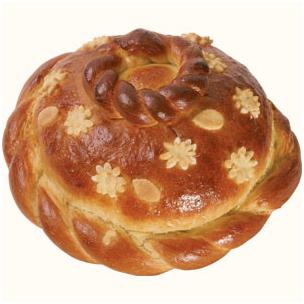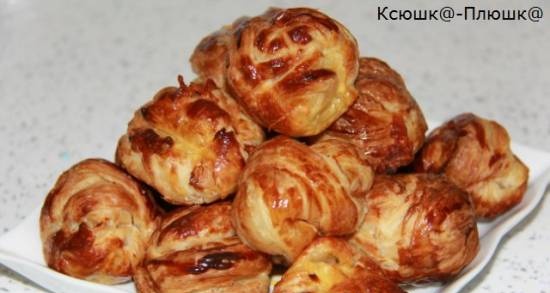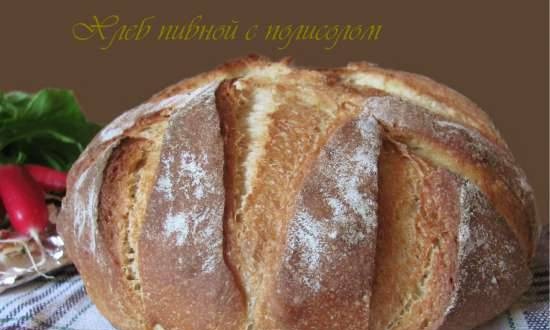I was terribly long toiled with the Raisin file (to which Shurshun gave the link above), but there is no more strength. I'm spreading what I did.
File from Zest (the one from LJ Ludmila), part one.Aunt Besya has already published it, I will duplicate it with pictures. At first I thought, just throw pictures to Tete Bese ... In the end I got confused and decided from scratch (but a little bit).Loaf

Loafs are very easy to bake if you already know how to bake ordinary round hearth bread made from sponge dough. A loaf, in the modern or ritual sense of the word, differs from any other bread in that it is decorated on the surface either with the same dough from which the bread is baked, or with a special decorative dough without yeast (a cross between dumplings and gingerbread dough).
Since the loaf is, first of all, very tasty bread, it can be very, very rich, almost as rich as Easter cakes, except perhaps without raisins and candied fruits, or simply rich, like sweet buns, or so uncomfortable, simple, that there will be less fat and sugar in it than in sliced loaves and cakes.
How sweet or nourishing the loaf is, and even from what flour it is baked - wheat or rye, is not so important as the symbolic decorations suitable for the occasion on the surface of the loaf, the framing of its sides and crown - braids and pigeons-swans on the wedding loaf, salt in a salt shaker in the depression or in a dough cup on top of a loaf, when a loaf (the so-called "bread and salt") is baked on the occasion of dear guests in the house, or ears of wheat and other plant motifs are symbols of prosperity and prosperity, if the loaf is baked to mark the end of the feast harvest or birthday, etc.
Below I give three recipes for loaf dough in accordance with GOST: small sweet butter loaves (Peter's) and giant, more bread loaves, souvenir and Russian.The Russian loaf is the breadiest of all, the simplest in composition, and the dough for it must be thoroughly kneaded on a well-fermented dough to emphasize the high quality of wheat bread. Russian loaf is baked into white bread with a straw or light golden crust, in contrast to the much more rich Ukrainian korowai, in which the crust is most often dark glossy, raspberry-burgundy.
I will give illustrations of the step-by-step execution of bread according to these recipes in separate articles, since this article is more about what loaves are and how they look and it is already very long. For those who already know how to bake bread, recipes and pictures in this article are enough.
Loaf "Petrovsky" weighing 300g

For 1 loaf
190g flour c. from.
2.7 g pressed yeast (1.5 g western)
3.3 g salt
30g sugar
24g margarine
10g eggs
83g milk or water
Prepare dough: take 35-60% of all flour, yeast and fashion or milk to make a dough like for a pancake. stir and simmer in warm for 3 hours for fermentation. When the dough grows and begins to sag, knead the dough. Let the dough ferment for 2.5 hours with 2-3 strokes during fermentation.
For decoration, a rose is prepared from dough. A piece of dough is rolled out into a cake, circles of dough are cut out with a round notch and 3-4 circles are placed one on top of the other with only one edge. Wrap it in a roll, press firmly in the center with your fingers, break it in half in the middle and straighten it in the form of a rose (you get 2 roses).

After a roll of dough circles has been ripped or cut in half in the middle with scissors, each rose can be opened slightly or strongly with petals.

To obtain leaves, the dough is rolled into a layer 3-5 mm thick, oblong wedge-shaped figures are cut from it, cuts are made in a herringbone around the edges with a knife, then the wedge is slightly stretched in length.
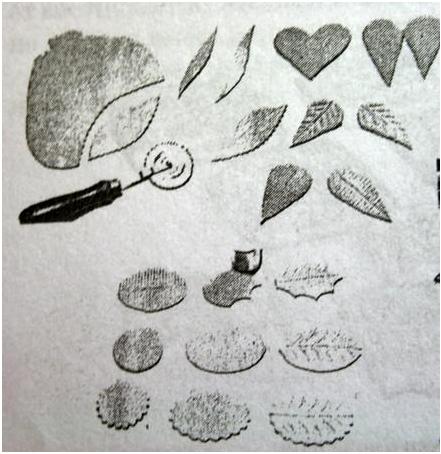
Roll the remaining dough and dough trimmings into a ball and place on a baking sheet with the seam down. After 10-20 minutes of proofing, make a depression in the center for decoration.
The places where the decorations will be laid are slightly moistened with water, the rose is placed in the center of the ball, the leaves are on the sides.
After registration, give the loaf to distance, grease with vegetable oil and bake. After baking, brush the crust with margarine or butter.
Source: E. I, Peretyatko (2006), Confectioner. Tutorial.
Loaf "Souvenir" weighing 2 kg

OST recipe: 1 kg of flour c. pp., 20g of pressed yeast (10g of western), 13g of salt, 100g of sugar, 80g of margarine, 200-226g of fat milk, 80g of eggs, water until a soft dough is obtained. Hearth round bread weighing 2 kg. The shape is round, without side protrusions and imprints, with a slightly convex upper crust. The surface is glossy, finished with a pattern in the form of ears, flowers, leaves and other arbitrary pattern. At the base, the product is entwined with a cord.
1978 recipe.
Opara
450g flour
20g yeast (10g western)
120g water
226g full fat milk
Knead for 4 minutes, until smooth. Let the dough ferment in the heat for 3.5-4 hours or until it is raised and begins to sag in the center of the dough dome.
Dough
500g flour (+ 50g flour for cutting)
13g salt
pinch of ascorbic acid
100g sugar
70g margarine in dough (and 10g for cutting)
40 g eggs per dough (and 40 g for finishing the product)
Water until a soft dough is obtained (about 150-200g)
Knead in dough for 10 minutes until a smooth dough with well-developed gluten. Leave for 1.5 h of fermentation with one stirring after 45 min of fermentation. Separate a piece of dough for decorations.
Roll the finished dough into a ball and let it pre-proof for 5-20 minutes. Next, shape the round bread and place it on a floured towel in a basket or colander, seam up, to proof in a warm, damp place. Duration of soaking is 30-40 minutes.
Meanwhile, decorations are being prepared. To decorate the souvenir loaf, harnesses and figures in the form of stars (or snowflakes), ears, leaves, flowers and other arbitrary patterns are prepared.
To make stars or snowflakes from a layer of dough with a thickness of 2 mm, circles with a diameter of 1.5-2 cm are cut out with a tube.Small radial cuts are made in the circles with a knife or scissors, and the resulting petals are turned at an angle of 30-45 degrees.
To make leaves from the dough, pieces are cut in the shape of leaves.


To make ears of dough, thin bundles are cut out, which are shaped into ears with small scissors.
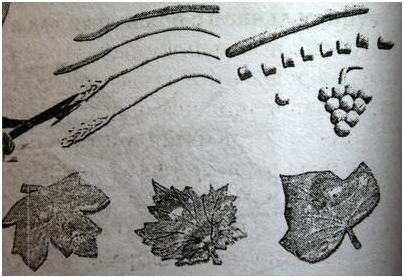
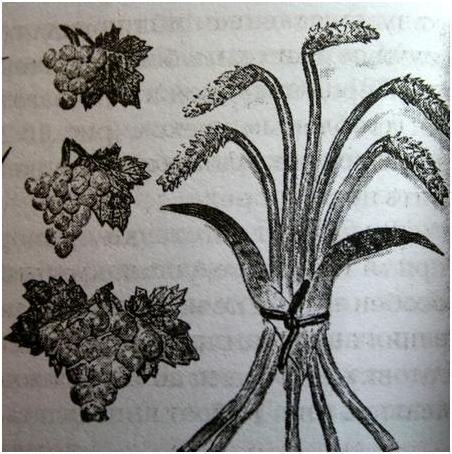
Before planting in the oven, the harnesses for the ears are greased with an egg and cut.
Bake on baking stone heated to 400F for 1 hour - 1 hour 15 minutes until cooked.
Source: A. N. Andreev (2003) Production of baked goods.
Loaf "Russian" weighing 2 kg
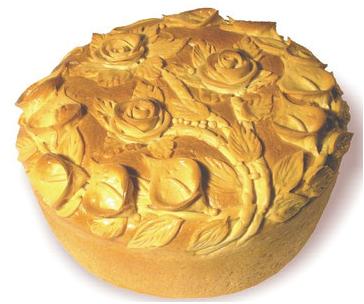
Recipe according to GOST: 1 kg of wheat flour c. pp., 20g of pressed yeast (10g of fresh yeast of Western production), 13g of salt, 15g of sugar, 20g of margarine, 100-115g of fat milk, water (about 550-650g, depending on the strength and dryness of the flour). Sponge dough. Round shaped or hearth bread weighing 2 kg. Furnace at 425F for 1 hour - 1 hour 15 minutes.
Source: Bakery products. Recipes and recommendations. Perm, 2007.
Illustrations

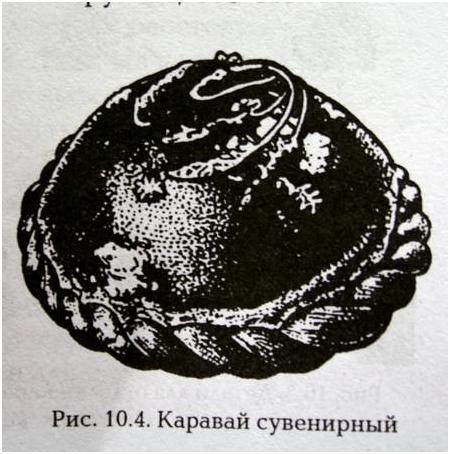
Rope from two bundles of dough, stars and leaves, ears of wheat for a souvenir loaf

Pictures of loaves from the sites of bakeries and other sites on the Internet.
The simplest ornaments for decorating loaves (bread-salt) with the help of a flagellum of bread dough and cut-out snowflake flowers for beginners. The dough can also be decoratively chopped in strategically needed places.


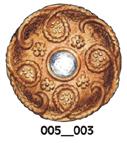
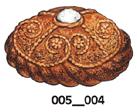

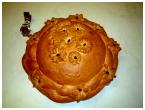
Decorating a distant loaf before baking

Distance loaf before baking

Ready loaf
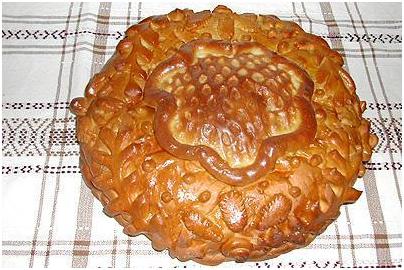
It is not necessary to decorate the loaf abundantly, a braid around the perimeter of the bread is enough, and a marked place for a salt shaker or salt on the top of the head. In addition, the loaf does not have to be baked with a huge, kilogram. They are baked in convenient sizes.
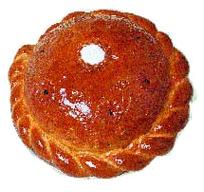
When a loaf is baked for a feast on the occasion of an anniversary, birthday and other significant dates, then instead of a figuratively decorated round place for salt or a saltcellar on the top of the loaf, you can place applications in the form of numbers, initials, inscriptions, etc.

It is allowed to use a small amount of raisins in decoration, for example, in the center of flowers.

A simple string can be laid in one or two rows, and along the bottom and on the top of the loaf, and you can use the same string of two or three bundles of dough to decorate the sides of the bread.

Depending on the amount of baking in the dough and preferences, the color of the crust of the loaf can be either very light or very, very dark. After baking, the loaf rind can be greased with nothing, or greased with butter, for softness, or sugar syrup or starch brewed in water, for shine.
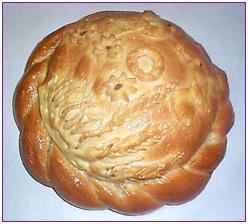

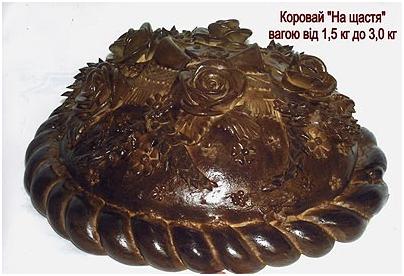
The loaf does not have to be baked on a hearth or on a baking sheet. It can be baked in a round form, in a pan, deep or not very deep. In this case, you can leave the string with a string along the bottom of the bread, or frame the bread around the perimeter with balls of dough. Each such bun can be decorated separately on the top and sides.


Not all loaves are formed from below with a string of a pair of dough flagella. Some loaves are not framed with strings at all, but are finished exclusively with applications on the surface.
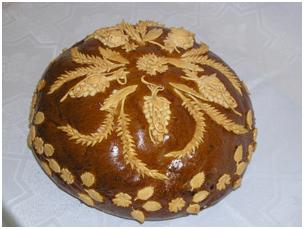
On the other hand, you can frame the bottom and top of the head not with a string, but with braids made of dough, from any odd number of strands. How do you like.

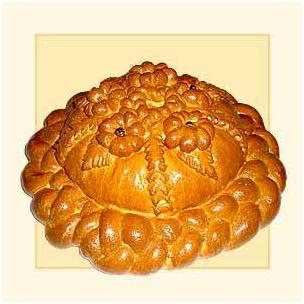
And, finally, examples of decorating the surface of bread with applications made from dough with microscopic yeast content, from shortbread or from a special fresh decorative dough. Unleavened decorative dough is obedient and pliable like plasticine, holds its shape well and, if it is not greased with an egg before baking, the pattern will turn out to be of a contrasting color, which can be very beautiful. Highly. If you want to try to decorate a loaf with figurines from unleavened dough, then the recipe is
Decorative dough
Bring 90g water, 90g sugar and 45g corn syrup or light honey to a boil and cool. Pour 3-3.5 cups of white rye flour into the resulting syrup and knead until a smooth dough is obtained. Do not knead until smooth, otherwise the jewelry will be covered with bubbles and "blisters" in the oven.
Instead of 3.5 cups of white rye flour, you can take 2.5 cups of white rye flour and 1 cup of buckwheat flour. This dough will make the decorations even smoother and will definitely not bubble during baking.
This dough can be tinted with burnt sugar or cocoa, or paprika (powdered sweet red pepper) or turmeric / saffron). If you want to get very light, almost white, decorations, then part of the rye flour can be replaced with wheat or all the rye flour can be replaced with wheat, preferably confectionery flour.
After baking, the decorative dough appliqués will have a matte surface. For shine, you can grease them with sugar syrup after baking. Pate morte recipe from J. Hamelman (2004) Bread.

